
This year’s Epic User Group Meeting (UGM) was packed with announcements, as Epic Systems continues to position itself as the enterprise platform, artificial intelligence (AI) engine, and healthcare data center of the future. From the unveiling of Epic CoMET to healthcare-focused enterprise resource planning (ERP) capabilities in EpicOps, here’s a recap of Epic’s latest developments—including what’s here, what’s coming soon, and how healthcare leaders can prepare for what’s next.
1. Cosmos AI + CoMET
Epic continues to build on Cosmos AI with the announcement of the Cosmos Medical Event Transformer (CoMET) models, a set of AI models pre-trained on 300 million patient records and 16 billion medical events.
While many of Cosmos AI’s capabilities are still under development, early research shows that CoMET is already matching—or outperforming—task-specific models in diagnosis prediction and disease prognosis, making it a powerful tool for both research and clinical applications.
2. Epic AI Agents: Art + Emmie + Penny
Epic also announced a trio of AI agents built to support patients and providers alike, including:
- Art: A clinician-facing AI tool that aims to provide real-time visit support, clinical insights, and new ambient scribe capabilities via Microsoft’s Dragon technology.
- Emmie: A patient-facing AI tool embedded within the MyChart patient portal that allows patients to ask questions about test results, prep for future visits, and even get help scheduling visits or recommended screenings.
- Penny: A revenue cycle AI assistant designed to help staff speed up medical coding and draft appeal letters, with additional rev cycle capabilities planned for future release.
Penny’s initial capabilities are already live, but both Emmie and Art are expected to be available to Epic customers later this year, with Art’s note-taking capabilities slated to be released in early 2026.
TALK TO AN EPIC EXPERT
3. EpicOps
After Epic Teamwork made headlines earlier this year at HIMSS25, Epic announced their roadmap for EpicOps across three categories—Workforce, Materials, and Financials—through 2027. Billed as a “healthcare-focused, natively integrated ERP,” the next release will include the Time & Attendance module, while additional modules, such as Credentialing, Inventory Management, Procurement, Item Catalog, General Ledger, and Cost Accounting, are slated for release in early 2026.
4. Epic’s Ambient Scribe + Microsoft
One of the most tangible examples of Epic embedding AI into day-to-day workflows is its deepening partnership with Microsoft and Nuance. Through the integration of Dragon Ambient eXperience (DAX), Epic is bringing real-time note creation into Hyperspace and mobile apps. Physicians can have their conversations with patients automatically converted into structured clinical documentation—reducing clicks, freeing up time, and improving provider satisfaction.
Importantly, Epic is taking a dual-track approach: building its own long-term AI-native documentation solutions (via its Art agent), while also leaning on Microsoft and Nuance to deliver proven ambient scribe capabilities today. Early pilot sites have reported time savings per encounter and higher quality notes, validating that this technology is ready for frontline adoption.
How to Prepare for What’s Next with Epic & AI
With more than 160 different AI tools currently in development, it’s clear that Epic is going all-in on artificial intelligence—or what Judy Faulkner, Epic’s founder and CEO, calls “healthcare intelligence.”
So what can healthcare organizations do to prepare for what’s next? Whether you’re already using Epic or monitoring trends in the market, we recommend keeping the following questions in mind:
- How do we safely adopt and govern embedded AI across access, clinical, and financial domains?
- How can we balance cost pressures while investing in the enterprise capabilities Epic is rolling out?
- How should we leverage Epic’s scale as a healthcare data center to drive local transformation?
The Bottom Line
Epic is moving fast, and the list of new features, modules, and AI capabilities grows every year. The challenge for health systems isn’t just hearing about what’s new at UGM—it’s knowing what to prioritize, how to adopt it safely, and how to turn it into measurable value for your organization.
That’s where Healthcare IT Leaders comes in. We stay ahead of Epic’s roadmap so you don’t have to, giving you the strategic guidance and delivery muscle to move from awareness to execution. Whether it’s deploying CoMET models, piloting AI agents like Art, Emmie, and Penny, or standing up EpicOps modules, we help you go beyond the announcement stage and actually bring these innovations to life inside your health system.
With proven expertise across the entire Epic ecosystem—EHR, RCM, ERP, WFM, and AI—paired with cost-effective nearshore and onshore managed services, we ensure that your organization not only keeps pace with Epic’s evolution but also realizes the full ROI of your Epic investment.
TALK TO AN EPIC EXPERT
The post 4 Things to Know About the Future of Epic & AI first appeared on TechToday.
This post originally appeared on TechToday.
